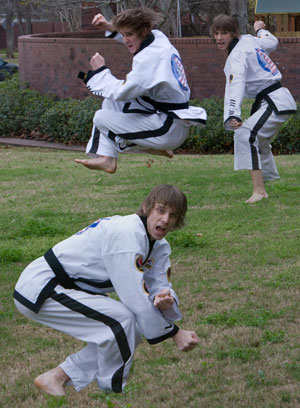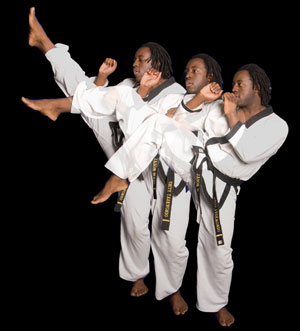A Brief History
Taekwondo originated in Korea about 2,000 years ago. It was developed as a form of unarmed self-defense to go along with skills with weapons. According to the World Taekwondo Federation the first recorded evidence of this martial art was found in a tomb from the Koguryŏ Kingdom (37 BCE to CE 668), in a mural showing figures practicing martial arts techniques. Historical records from this period indicate that there were taekwondo tournaments.
Taesoo, kwonbak, kongsoo, bakhi, and dangsoo are all names for early forms of what is now known as taekwondo. Soobak was the mainstream form between CE 600 and 1400; starting in the late 1300s this was renamed taekyon. Taekyon was the main Korean martial art form until 1909, when Japan invaded and occupied Korea. Between 1909 and 1945, Korean culture and martial arts were suppressed and the Japanese culture and martial arts were introduced.
|
360º back fist, performed by Sky Wood (3rd Dan Kyosa Nim). |
When the Japanese were defeated in 1945, the modern period of taekwondo began. Korean martial arts masters began discussions on how to return to the original taekyon style and on how to merge the different martial arts schools called kwans, into a single style and national sport. Finally, in April 1955, the masters from the different kwans chose the name taekwondo.
Taekwondo was accepted as an official sport in 1975 by the U.S. Amateur Athletic Union (AAU). Today, taekwondo is a fast-growing international art and competitive sport and is practiced in more than 190 counties worldwide. It was a demonstration sport at the 1988 Summer Olympic Games in Seoul, South Korea, and became a medal sport in 2000 at the Sydney Games, for men and women.
Choi Hong Hi, known as General Choi, is considered by some to be a founder of modern taekwondo. His theory of creating maximum power can be summarized in six parts:
- Reaction force—Newton’s third law, which states that for every action there is an equal but opposite reaction, is the basis for General Choi’s reaction force principle.
- Concentration—applying force to the smallest target area, based on pressure being equal to force multiplied by area.
- Equilibrium—maintaining one’s center of gravity or balance.
- Breath control—controlling one’s breath can increase the power of a blow.
- Mass—the most power is gotten by using the maximum body weight and speed.
- Speed—the most essential factor because it unites the previous five factors.
|
Triple front kick, demonstrated by Jason Wade (1st Dan). |
General Choi used a classical mechanics equation to summarize the relationship between mass, speed, and power. The formula E=1 / 2(m x s2) shows why a fast lightweight could generate more power than a relatively slower heavyweight. The formula states that the energy of a moving object (E) equals its mass (m) multiplied by its squared speed (s) divided by two. So, if you somehow doubled the mass behind your punch, then your resulting energy, or power, would increase by two units (half the mass), but if you doubled the speed of your punch, then your power would increase four times (speed squared). In short, a speedy lightweight can create more power than a more muscular, but slower, heavyweight.
This content has been re-published with permission from SEED. Copyright © 2025 Schlumberger Excellence in Education Development (SEED), Inc.



